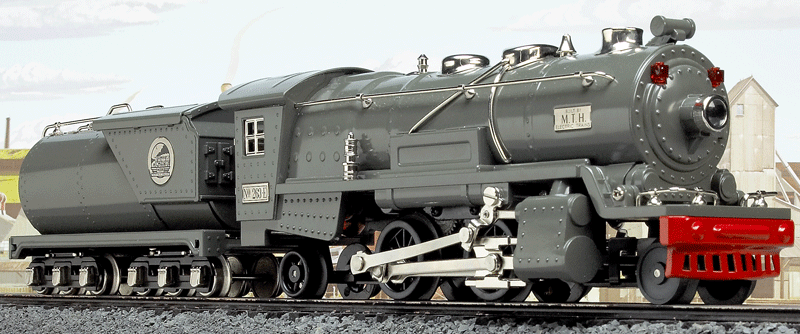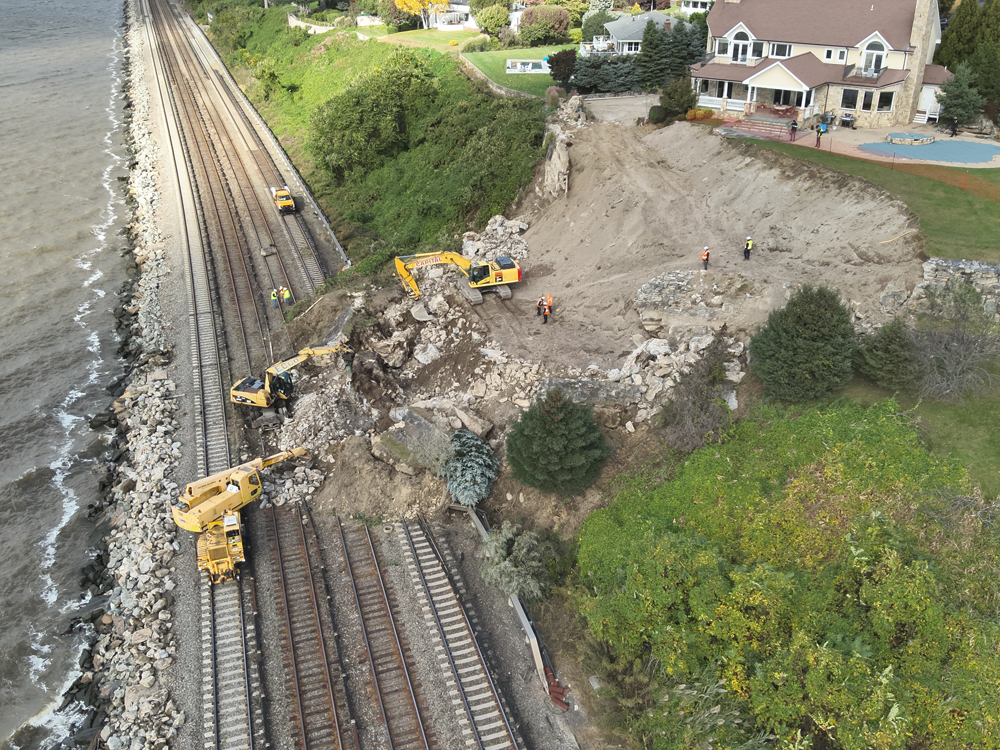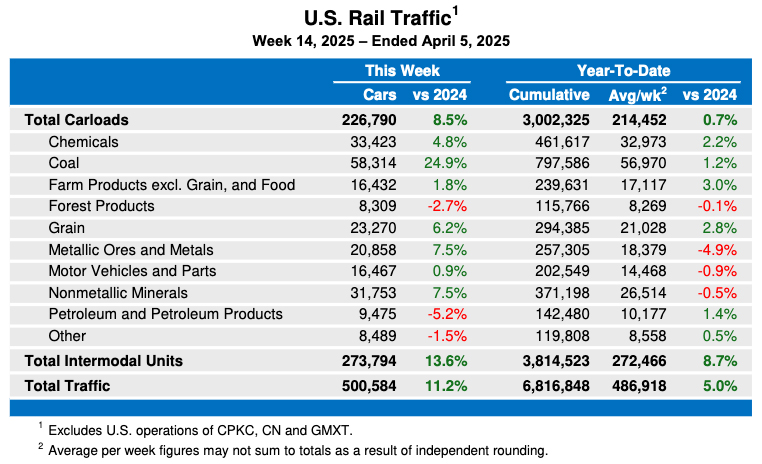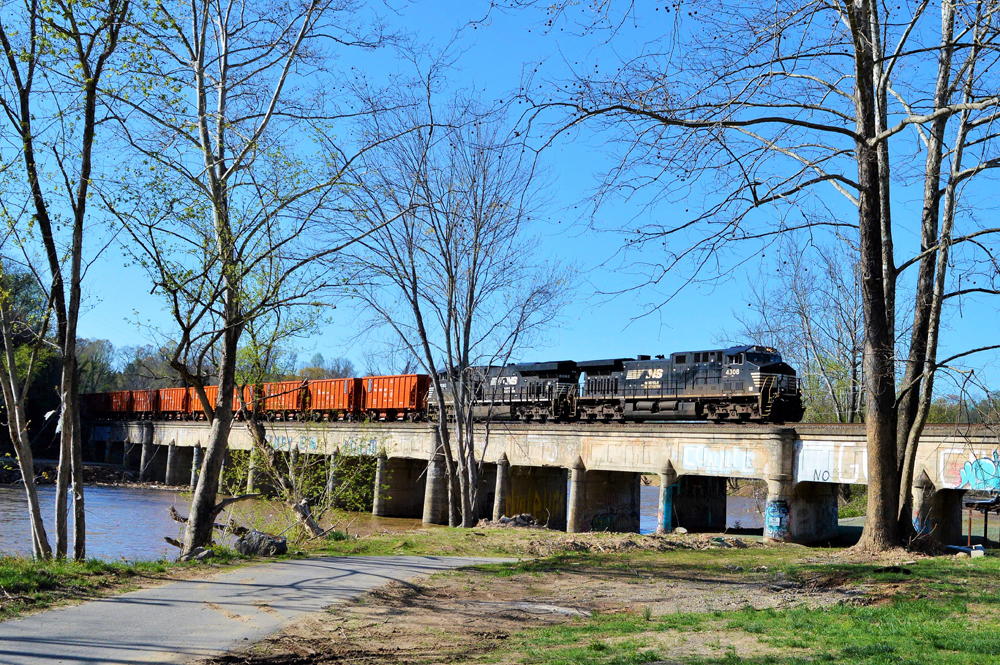The tinplate O gauge 2-4-2 locomotive was everything that its die-cast metal successors were not. It was glossy and bold and featured plenty of smooth sheet-metal surfaces accentuated by stamped rivets, nickel ladders, railings, and domes, with a red cow-catcher thrown in too. One pinky-tip sized bulb lit up the nickel-rimmed headlight, and another glowed red beneath the cab floor to simulate a blazing firebox.
Inside the original locomotive was an open-frame motor placed transversely between the drive wheels on a metal frame. The Vanderbilt-style oil tender contained Lionel’s then-new air whistle. Also added to the rear was the then-new box-style coupler, a precursor of Lionel’s postwar knuckle coupler.
MTH has duplicated most of these features and added a 21st century twist in its latest re-creation of the 263E.
The model
The 263E was the last top-end sheet-metal locomotive that Lionel produced. Cataloged between 1936 and 1939, it was visually similar to the earlier no. 260 locomotive, but came with a different tender, blackened wheels, red plastic marker lights on the boiler front, and added eccentric rods.
MTH’s model does the original proud, matching all of its external features and nickel trim pieces.
We showed the MTH 263E to John Grams, who regularly writes stories about prewar trains for CTT. John is somewhat of a purist, but he liked the locomotive. However, he thought that the gunmetal-gray paint job on our sample fell short. Specifically, it lacked any of the metallic sparkle and depth of the original Lionel gunmetal locomotives, which John said few manufacturers have been able to duplicate in contemporary reproductions.
MTH also catalogs its 263E in two-tone blue (reminiscent of the locomotive in Lionel’s no. 283W outfit known as the “Baby Blue Comet” from 1936-37) and black with an apple-green stripe on the frame. Be aware that the latter scheme, while attractive, does not duplicate a Lionel original.
Aside from paint, the only external nit to pick was the presence of anachronistic Phillips head screws along the locomotive frame. The original 263E used slotted-head screws (Stanley tools didn’t manufacture its first Phillips head screwdriver until a year after the 263E debuted).
It’s along the locomotive’s frame or, to be specific, what is mounted within the frame, where things get interesting. Above the rear set of drivers is a can-style motor mounted length-wise. Wrapped around the motor’s flywheel, just below the firebox, is a striped section of tape that is part of the locomotive’s ProtoSound 2.0 speed-control mechanism.
Yes, on the outside this locomotive is pretty much a dead ringer for a prewar train. On the inside, though, it has all the ProtoSound 2.0 goodies that typify modern O gauge steam locomotives.
An electrical tether connects the motor and the smoke unit (yes, it has a fan-driving puffing unit too) in the locomotive shell to the Digital Command System circuit boards and a audio speaker within the tender. A look at the underside of the tender reveals the secrets: openings for the steam sounds to escape, a switch to turn the sound system off, a jack for a battery charger, and a potentiometer to adjust sound volume. Even the box-style coupler on the tender fires open at the press of the uncoupler button on the MTH DCS controller.
On the test track
The MTH 263E is a hybrid in the best sense of the word. While it lacks the growl and coasting ability of an old open-frame motor and mechanism, the synchronized steam-locomotive sound, puffing smoke, and refined throttle control more than make up for the absent old-world charms.
Our sample performed smoothly at all throttle settings. Thanks to its speed-control circuitry, we recorded a low-speed average of 3.8 scale mph and a high-speed average of 61.7 scale mph. The locomotive, which weighs 5 pounds 14 ounces, recorded a drawbar pull of 1 pound 5 ounces, fairly respectable given that it has no traction tires and Magne-Traction was only a dream when the original was built. The locomotive is designed for O-31 and wider curves.
Some locomotives in the Lionel nos. 260/263 family were built using Standard gauge wheels, primarily on their tenders. These wheels have deeper flanges than O gauge wheels. While that is no problem on regular O gauge track, these wheels often hit the ties on Lionel O-27 and other lower-profile brands of track and switches.
With that in mind, we tested the MTH 263E on straight and curved sections of Lionel O-27, MTH Realtrax and Scaletrax, Atlas O track, Lionel FasTrack, and GarGraves track and did not experience any contact problems with the tops of the ties. We even tried the locomotive on Lionel O-27, Atlas O, and MTH Realtrax 90-degree crossings and had no problems, although the bottom of the flanges did lightly graze the recessed areas of the crossings. On Super O straight track, the flanges lightly bumped the wire clasps that hold the rails to the plastic ties.
The huge variety of O gauge specialty track sections and track switches makes it impossible for us to check each and every track scenario, so be careful if you operate a prewar-style locomotive on low-profile O gauge rails.
All the ProtoSound 2.0 functions operated as advertised. While we were testing the 263E, all the visitors to our workshop had delightfully puzzled looks on their faces while watching what appeared to be a 70-year-old locomotive audibly chuff and visually puff its way around our test track under the control of a wireless DCS controller.
There are still toy train enthusiasts that scoff at the idea of mixing tinplate and high-tech, but the MTH 263E is a joy to look at and to operate. What more could you want in an O gauge locomotive?
Price: $429.95 (no. 10-3015-1)
Features: Sheet-metal boiler and tender with nickel trim, firebox glow, ProtoSound 2.0 including speed control, and fan-driven smoke unit
Pros: Highly attractive and faithful reproduction with smooth-running modern mechanism and full suite of ProtoSound 2.0 features
Cons: Electrical tether looks clunky, gunmetal gray paint lacks metallic sparkle of original
Made in the People’s Republic of China for MTH Electric Trains















Very good
Am seriously thinking of getting one. It will match
my other prewar trains.
Keep up the good work, about spreading the word on
toy trains.
Regards